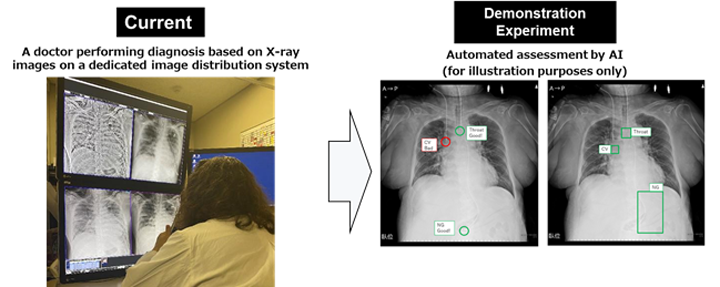DEC
Four-party consortium conducts a demonstration experiment of emergency medical care using 5G at St. Marianna University School of Medicine Hospital
~ Aims to contribute to the enhancement of emergency medical care that helps disaster medicine as well as addressing long working hours of doctors and nurses ~
December 2, 2021
transcosmos inc.
St. Marianna University School of Medicine
NTT DOCOMO, INC.
Kawasaki City
A four-party consortium composed of transcosmos inc. (transcosmos), St. Marianna University School of Medicine (St. Marianna University), NTT DOCOMO, INC. (DOCOMO), and Kawasaki City hereby announces that the consortium will begin a demonstration experiment of emergency medical care (the experiment) with the use of 5G at the St. Marianna University School of Medicine Hospital (St. Marianna University Hospital) on Monday, December 6, 2021. The experiment has been chosen by the Ministry of Internal Affairs and Communications for its public appeal for “The fiscal 2021 development demonstrations for realizing local 5G services to solve issues.”
Given an increasing aging population and other factors, the need for emergency medical care has risen sharply in recent years. In order to address such a need as well as to manage mass-casualty incidents and prevent the spread of emerging contagious diseases, it has become a pressing task to further strengthen the emergency medical service system to promote the development of sustainable community health and medical services. In addition, some reports have pointed out that doctors tend to work long hours in medical institutions that accept many emergency patients including St. Marianna University Hospital, which calls for an appropriate allocation of medical resources.
With the aim of solving such challenges that community and emergency medical services face, and to streamline emergency medical care and address the long working hours, the four-party consortium will develop and experiment the following systems using DOCOMO’s 5G services that enable medical institutions to realize real-time communication between doctors and hospitals through many-to-many high-definition video transmission, transmit large-volume video data from medical equipment, and assess the position of medical equipment with the use of AI.
- (1) Share comprehensive visual information by using 360 cameras and other tools. Share visual information of doctor’s hand movements with the use of smart glasses
- (2) Share visual information of a patient who is on a transfer on a stretcher in the hospital
- (3) Share remote CT images
- (4) Transmit mass X-ray video data
- (5) Assess the position of endotracheal tubes and other medical tools with the use of AI
Based on the results of the experiment, the four-party consortium will first discuss systems’ operational challenges and solutions, and implement the systems to St. Marianna University Hospital in full-scale. The consortium will continue its efforts in finding ways to maintain medical care systems that enable medial institutions to accept many patients smoothly and effectively, streamline operations for healthcare professionals, and address their long working hours.
Also, the consortium will report the findings of such initiatives to the Japanese government, and will strive to apply and spread the systems to community health and medical services.
| Media Contacts | |
|---|---|
| transcosmos inc. Public Relations & Advertising Department Email: pressroom@trans-cosmos.co.jp |
St. Marianna University of Medicine Department of Emergency and Critical Care Medicine/Digital Health Co-creation Center TEL: +81-44-977-8111 (Extension: 3931/3619) |
| NTT DOCOMO, INC. Corporate Sales and Marketing Department, Kanagawa Branch TEL: +81-45-226-8041 |
KAWASAKI CITY Healthcare Policy Office, Health and Welfare Center TEL: +81-44-200-2420 |
Demonstration Experiment Overview
1. Demonstration Experiment Overview
(1) Place
St. Marianna University School of Medicine Hospital (Sugao, Miyamae-ku, Kawasaki city, Kangawa prefecture, Japan)
(2) Start Date
Monday, December 6, 2021
2. Abstracts (refer to the reference sheets for images and details of the experiment)
| Themes | Points to be verified | Main equipment and technologies | |
|---|---|---|---|
| (1) | Share comprehensive visual information by using 360 cameras and other tools. Share visual information of doctor’s hand movements with the use of smart glasses | Verify the feasibility of sharing information appropriately by sharing videos that livestream treatments carried out in the emergency room. |
|
| (2) | Share visual information of a patient who is on a transfer on a stretcher in the hospital | Verify the feasibility of checking patient conditions whilst on transfer inside the hospital on a stretcher in real time. |
|
| (3) | Share remote CT images | Verify the feasibility of performing diagnosis by taking the images of CT scans with 4K videos and sending the images to doctors’ tablets. |
|
| (4) | Transmit mass X-ray video data | Verify the feasibility of performing diagnosis by transmitting high-definition X-ray video data to designated PCs in real-time. |
|
| (5) | Assess the position of endotracheal tubes and other medical tools with the use of AI | Verify the feasibility of browsing the results of AI-based analysis on tablets by uploading X-ray images taken with 4K cameras on cloud. |
|
3. Main Roles and Responsibilities of Each Party
| Company/Organization | Main Roles and Responsibilities |
|---|---|
| transcosmos |
|
| St. Marianna University |
|
| DOCOMO |
|
| Kawasaki City |
|
Demonstration Experiment Details
(1) Share comprehensive visual information by using 360 cameras and other tools. Share visual information of doctor’s hand movements with the use of smart glasses
| Current Status | Although many doctors and medical staff are called to attend patients when accepting severe trauma patients or following mass casualty incidents, many of the doctors cannot treat the patients swiftly. There is room for improvement in operational procedures. |
| Experiment Details | Experiment will be conducted assuming two cases. One is to remotely observe and grasp the situation of emergency treatment performed on severe trauma patients, and the other is to remotely observe and grasp the situation of doctors’ examination on multiple patients following mass casualty incidents. Video images of a doctor’s surgical procedures and the condition of affected areas will be shared by the use of a smart glass. In addition, vital sign monitors, whiteboards on which patient’s complaints, the course of events, and any other information are described, as well as medical staff attending the patient, will also be shared using 360 cameras and other equipment. |
| Expected Benefit | Doctors will be able to remotely check and grasp a patient’s condition without being on a medical site, which enables them to go to the site when necessary. Therefore, it is expected that the process will reduce the duration of doctors being on site, as well as decrease the number of doctors on site. In addition, this enables more doctors and medical staff to share information about the situation at the medical sites. The ability to share information between the medical sites, a control room, and areas where patients are transferred (operating room, hospital laboratory) in real time will optimize and streamline the procedures for deciding a therapeutic approach based on the severity and required treatment of each patient, triage, and the time for doctors to move to designated areas for treatment and examination. |
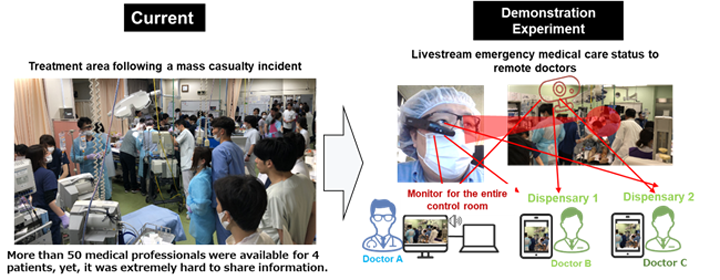
(2) Share visual information of a patient who is on a transfer on a stretcher in the hospital
| Current Status | In case of a sudden change in a patient’s condition, many doctors and nurses currently attend an emergency patient on transfer on a stretcher in a hospital which requires a lot of manpower and man-hours. |
| Experiment Details | In the experiment, videos of an emergency patient on transfer on a stretcher inside the hospital will be livestreamed to remote doctors’ tablets using 5G. This enables doctors to grasp the patient’s condition who is on transfer from ICU to the angiography suite or other areas where less doctors are present, which is a common case for severe patients. |
| Expected Benefit | It is expected that by enabling doctors to remotely grasp patients’ conditions, they will be able to attend the patients in case of emergency even if staff in charge of transfer are not qualified for medical treatment. Therefore, it is expected that this will reduce the number of staff responsible for transferring patients as well as their mental burden. |
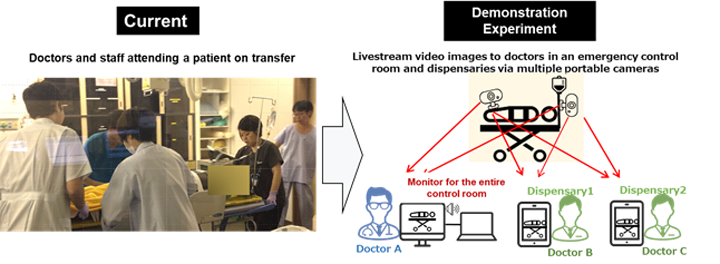
(3) Share remote CT images
| Current Status | Although novel coronavirus and other infection as well as traumatic changes must be tested and detected immediately, it currently takes time to carry out a diagnosis due to the long lead-time required for generating and transmitting images to a dedicated image distribution system. In addition, since the diagnosis needs to be performed with the dedicated image distribution system, it takes additional time for doctors to move to a diagnostic room and wait in the room. |
| Experiment Details | In this experiment, a 4K camera takes CT images that appear on a monitor after taking a CT scan, and then shares the images in real-time with medical image diagnosis specialists so that the specialists can confirm the images on their tablets. By sharing real-time, high-definition images using 5G, this allows the specialists to perform diagnosis based on the shared images without waiting for the images to be sent to an image viewer. |
| Expected Benefit | By sharing CT images in real-time, it is expected to save doctors’ travel and wait times. In addition, time-effective image diagnosis is expected to increase operational efficiency as well as quality of diagnosis as it can be performed by multiple doctors at the same time. |
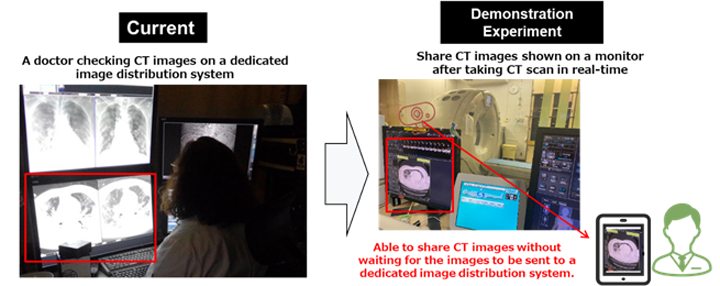
(4) Transmit mass X-ray video data
| Current Status | In order to transmit X-ray video data, X-ray specialists need to take X-ray videos in ICU and other areas where patients are treated, and move to a separate area where a dedicated server terminal for generating images is located. Thus, it currently takes more than one hour from taking X-ray videos to performing image diagnosis. |
| Experiment Details | The experiment will verify the feasibility of wireless mass video data transmission using unique features of 5G technology that is otherwise difficult. |
| Expected Benefit | Once medical equipment becomes more mobile in the future, the wireless mass video data transmission will enable doctors to analyze real-time image data (X-ray dynamic images) regardless of their locations. With this technology, there is no need to transfer patients, therefore, it is expected that burden on patients as well as manpower of medical staff for transferring patients will be reduced. |
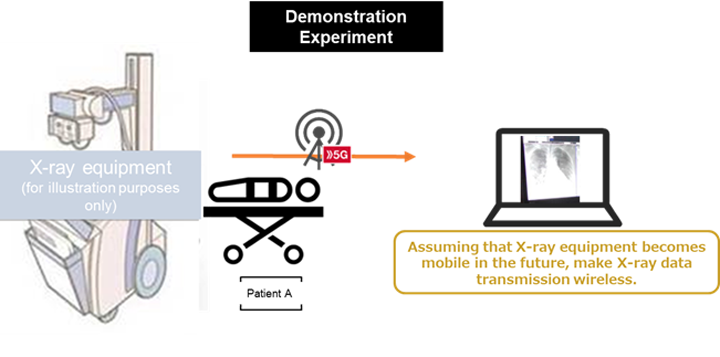
(5) Assess the position of endotracheal tubes and other medical tools with the use of AI
| Current Status | Severe and critical patients are intubated to endotracheal tubes and other medical equipment that assist breathing and support life. In order to confirm that such equipment is placed at the proper position of the patients’ body, X-ray radiography is required. In most cases, however, X-ray images are taken for other diagnostic purposes, and therefore doctors currently are required to perform diagnostic imaging to confirm the position of endotracheal tubes on top of other diagnosis. |
| Experiment Details | In the experiment, 4K cameras will take images of the X-ray images that appeared on monitors, and upload the mass video data on cloud using 5G. Once the upload process is completed, AI will be used to conduct an assessment, and the results of image analysis will be shown on tablet and other browsers in real-time. |
| Expected Benefit | 5G enables the transmission of high-definition video data, which in turn secures the level of resolution required for AI-based analysis. With the use of 4K cameras and other portable equipment, the system is highly flexible, and not restrained by existing image distribution systems installed in hospitals. With this system, it is expected to save doctors’ working hours whilst ensuring relevant diagnoses. |
